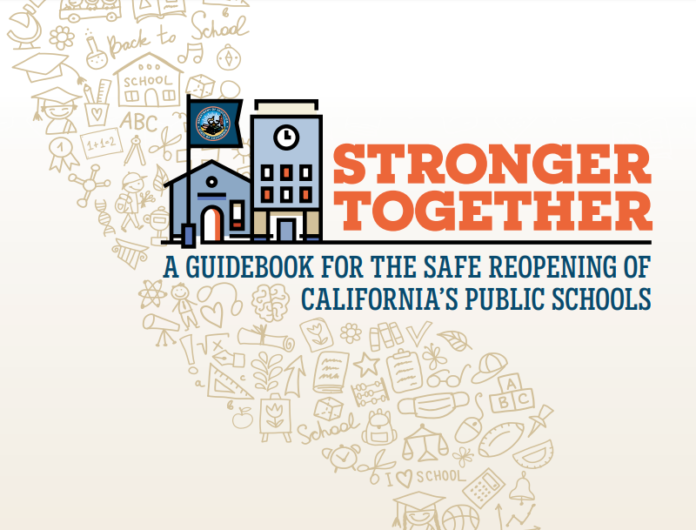Guidelines serve as a ‘how to’ and not as a mandate; SCOE expected to release county guidelines later this week
State Superintendent Tony Thurmond announced state guidelines for reopening schools Monday afternoon. Thurmond stressed that the guidelines, though extensive, allow districts the flexibility to decide if a hybrid model of education will work best for them, or if they have the means to send students back to school in full.
The introduction to the guide states that it isn’t a mandate, but that it’s intended to serve as a “how to” document, and that local school districts should work with local health departments and stakeholders to figure out what’s best for their district.
“Our guidance anticipates that many of our districts will be providing a hybrid model — a blended model — of educational instruction,” Thurmond said, noting that the state has surveyed parents throughout California and many hesitate to have their kids go back to school full time.
The 62-page document released by the state is supposed to work in tandem with direction given out at the county-level (here, it would be given out by the Sonoma County Office of Education), as well as guidelines set by the county health officer. The guidelines were created using guidance from the California Department of Public Health and the Centers for Disease Control and Prevention.
“It is not a ‘one-size-fits all’ document; rather it is a document that honors the varied local contexts of each of our local educational agencies (LEA). This guidance document was developed with the most current information known at the time and may be updated as new data becomes relevant. This guide will provide checklists, essential questions for consideration and examples of best practices,” reads the introduction to the state’s guide.
It indicates that the state will also be releasing guidance on standards for best practices when it comes to distance learning.
The checklist for reopening campuses is extensive, but advises districts to consider their cleaning, personal protective equipment (PPE) and thermometer availability, pointing out that districts should also consider the differing PPE requirements of students with disabilities. The guide also tells districts that they should establish a plan should schools need to close physical schools again, as well as develop a plan should a student, staff member, teacher or related family members test positive for COVID-19.
The guidelines also address limiting access to campus by minimizing “non-essential” visitors and volunteers.
Districts are also being advised to implement strategies to maintain social distancing, including suspending the use of shared tables or self-service buffets during food service, making sure desks are six feet apart, increasing supervision in outside spaces like playgrounds, among others.
The schedule modeling options that the state is recommending include a two-day rotation (where kids in a set number of grades would meet two days a week, and another set meet on the alternating two days); a second option is referred to as the A/B week blended model and involves half of the student population meeting in-person one week and another half meeting the following week, alternate weeks would be for online instruction; for K through eighth grades, the state outlined a looping structure of classes, wherein cohorts stay together instead of switching teachers during instruction; the last structure model presented involves a staggered schedule with same-day rotations for students, which would include staggered start and dismissal times and multiple lunch periods.
In a note to Cloverdale parents, Cloverdale Unified School District Superintendent (and soon-to-be Windsor superintendent) Jeremy Decker, who is one of the superintendents sitting on the county health committee focused on reopening schools, said that the county health official has yet to sign off on the Sonoma County Schools Re-Occupation Mitigation Plan.
“Within this proposed plan, guidance will be given to schools regarding the following: promoting behaviors that reduce spread, maintaining healthy environments, maintaining healthy operations, preparing for when someone gets sick and considerations for partial or total closures,” he wrote.
According to Decker, the plan requires that students aged 13 and up wear facial coverings and that social distancing of six feet will be required at all times while at school.
“Superintendent Decker and the other superintendents on the county health committee who are regularly meeting with County Health Official Dr. (Sundari) Mase are advocating that this requirement (the six-feet social distancing) be recognized as a best practice, but not a requirement due to the nature of student interaction and classroom instruction. We do not know if that allowance will be granted. We may receive more guidance next week regarding this issue,” the letter states.
The letter, directed at Cloverdale parents, said that “temperature checks will need to be conducted before any students are allowed to enter the classroom. Should a student have a temperature 100 degrees or more, they will not be allowed to enter the classroom. Again, there are ongoing discussions centered around this and the guidelines may change.”
Whether or not districts are able to engage in in-person learning is largely up to the guidance of Mase, since it correlates with where the county is at in its journey to reopening.
“SCOE and local school districts hope to use the health-approved strategies included in these plans, as well as any more specific guidance from county health that we will receive later this week, to build a guide that gives schools the greatest flexibility possible when creating their own custom plans for next year,” SCOE said in a statement following the release of the state guidelines. “The state makes it clear that schools must work with their local health officials to customize this guidance for the specific conditions and epidemiology within each county. We hope to release the Sonoma County Schools Reopening Guide by the end of the week, after receiving specific input and guidance from our own public health department.”









